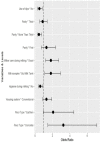Evidence-based identification and characterization of methicillin-resistant Staphylococcusaureus isolated from subclinical mastitis in dairy buffaloes of Pakistan
- PMID: 38269009
- PMCID: PMC10804429
- DOI: 10.22099/IJVR.2023.46970.6755
Evidence-based identification and characterization of methicillin-resistant Staphylococcusaureus isolated from subclinical mastitis in dairy buffaloes of Pakistan
Abstract
Background: Methicillin-resistant Staphylococcus aureus (MRSA), affecting livestock and human beings, has become a global public health hazard with economic consequences.
Aims: The current study was designed to investigate the prevailing MRSA-associated subclinical mastitis and associated risk factors in dairy buffaloes. The study also highlighted the genetic variations and in silico-based proteomic differences among MRSA isolates.
Methods: Out of 516 milk samples, 45.93% (237/516) were found positive for subclinical mastitis, while the prevalence of S. aureus was recorded 56.12%. The methicillin resistance in S. aureus isolates was evaluated by oxacillin disc diffusion test and molecular identification of the mecA gene.
Results: The results revealed a phenotypic and molecular prevalence of MRSA at 45.11% and 18.79%, respectively. The risk factor analysis revealed that among various assumed risk factors, parity, milking hygiene, milker care during milking, milk yield, housing system, and floor type were significantly associated with subclinical mastitis in buffaloes. The sequencing and phylogenetic analysis showed no significant genetic variations among study isolates and depicted a high similarity with isolates from Africa, USA, India, Italy, Turkey, and Iran. The in-silico protein analysis showed that all sequences had the same protein motifs resembling penicillin protein 2a except Buff-13, whose protein structure resembles alpha-catenin-like protein hmp-1.
Conclusion: The current study was the first report of the genotypic characterization and in silico protein analysis of MRSA from dairy buffaloes in Pakistan. The result highlighted the importance of antimicrobial resistance (AMR) and development of control strategies against MRSA infections.
Keywords: Antimicrobial resistance; Buffaloes; Mastitis; Methicillin-resistant Staphylococcus aureus; Phylogenetic analysis.
Conflict of interest statement
The authors declare no conflict of interest in the submission/publication of this data.
Figures












Similar articles
-
On-farm epidemiology, virulence profiling, and molecular characterization of methicillin-resistant Staphylococcus aureus at goat farms.Microb Pathog. 2023 Dec;185:106456. doi: 10.1016/j.micpath.2023.106456. Epub 2023 Nov 18. Microb Pathog. 2023. PMID: 37981077
-
First report on genotypic estimation of MRSA load in udder of nomadic sheep flocks affected with subclinical mastitis in Pakistan.Res Vet Sci. 2024 Jan;166:105107. doi: 10.1016/j.rvsc.2023.105107. Epub 2023 Dec 10. Res Vet Sci. 2024. PMID: 38096739
-
Prevalence of Mastitis and Phenotypic Characterization of Methicillin-Resistant Staphylococcus aureus in Lactating Dairy Cows of Selected Dairy Farms in and Around Adama Town, Central Ethiopia.Environ Health Insights. 2021 May 28;15:11786302211021297. doi: 10.1177/11786302211021297. eCollection 2021. Environ Health Insights. 2021. PMID: 34103935 Free PMC article.
-
Methicillin resistant S. aureus in human and bovine mastitis.J Mammary Gland Biol Neoplasia. 2011 Dec;16(4):373-82. doi: 10.1007/s10911-011-9237-x. Epub 2011 Oct 8. J Mammary Gland Biol Neoplasia. 2011. PMID: 21984431 Review.
-
Risk Factors for the Occurrence of Methicillin-Resistant Staphylococcus aureus in Dairy Herds: An Update.Foodborne Pathog Dis. 2020 Oct;17(10):585-596. doi: 10.1089/fpd.2019.2638. Epub 2019 Aug 28. Foodborne Pathog Dis. 2020. PMID: 31433237 Free PMC article. Review.
Cited by
-
Subclinical Mastitis in Small-Holder Dairy Herds of Gansu Province, Northwest China: Prevalence, Bacterial Pathogens, Antimicrobial Susceptibility, and Risk Factor Analysis.Microorganisms. 2024 Dec 20;12(12):2643. doi: 10.3390/microorganisms12122643. Microorganisms. 2024. PMID: 39770845 Free PMC article.
-
Repurposing of non-steroidal anti-inflammatory drugs for combination therapies to combat multidrug-resistant S. aureus of bovine reproductive tract origin.Vet Res Commun. 2024 Jun;48(3):1497-1510. doi: 10.1007/s11259-024-10322-2. Epub 2024 Feb 12. Vet Res Commun. 2024. PMID: 38347266
-
Detection and prevalence of antimicrobial resistance genes in multidrug-resistant and extensively drug-resistant Staphylococcus and Streptococcus species isolated from raw buffalo milk in subclinical mastitis.PLoS One. 2025 Jun 17;20(6):e0324920. doi: 10.1371/journal.pone.0324920. eCollection 2025. PLoS One. 2025. PMID: 40526704 Free PMC article.
-
On-farm epidemiology and phylogenetic evaluation of methicillin and beta-lactam-resistant Staphylococcus aureus isolated from dairy cattle and buffaloes with endometritis.Iran J Vet Res. 2024;25(2):98-106. doi: 10.22099/IJVR.2024.48563.7095. Iran J Vet Res. 2024. PMID: 39624190 Free PMC article.
References
-
- Abdeen EE, Mousa WS, Abdel-Tawab AA, El-Faramawy R, Abo-Shama UH. Phenotypic, genotypic and antibiogram among Staphylococcus aureus isolated from bovine subclinical mastitis. Pak. Vet. J. 2021;41:289–293.
-
- Abdul M, Malik R, Ijaz M, Islam A, Shahid A, Farooqi H, Hussain K. The prevalence and associated risk factors of Coa gene (coagulase positive Staphylococcus aureus) from bovine milk Kafkas. Univ. Vet. Fak. Derg. 2017;23:809–815.
-
- Ahmed A, Ijaz M, Khan JA, Anjum AA. Molecular characterization and therapeutic insights into biofilm positive Staphylococcus aureus isolated from bovine subclinical mastitis. Pak. Vet. J. 2022;42:584–590.
-
- Ali MA, Ahmad MD, Muhammad K, Anjum AA. Prevalence of sub clinical mastitis in dairy buffaloes of Punjab, Pakistan Okara. J. Anim. Plant Sci. 2011;21:477–480.
LinkOut - more resources
Full Text Sources
